If you're on the hunt for the best Australian Sauvignon Blanc, your journey will lead you straight to the nation's cooler climate pockets, where the most elegant, mineral-driven styles are born. The top drops, hailing from regions like the Adelaide Hills and Margaret River, offer a refined alternative to their Kiwi counterparts, striking a beautiful balance between zesty citrus and crisp, vibrant acidity.
Your Guide to Australian Sauvignon Blanc
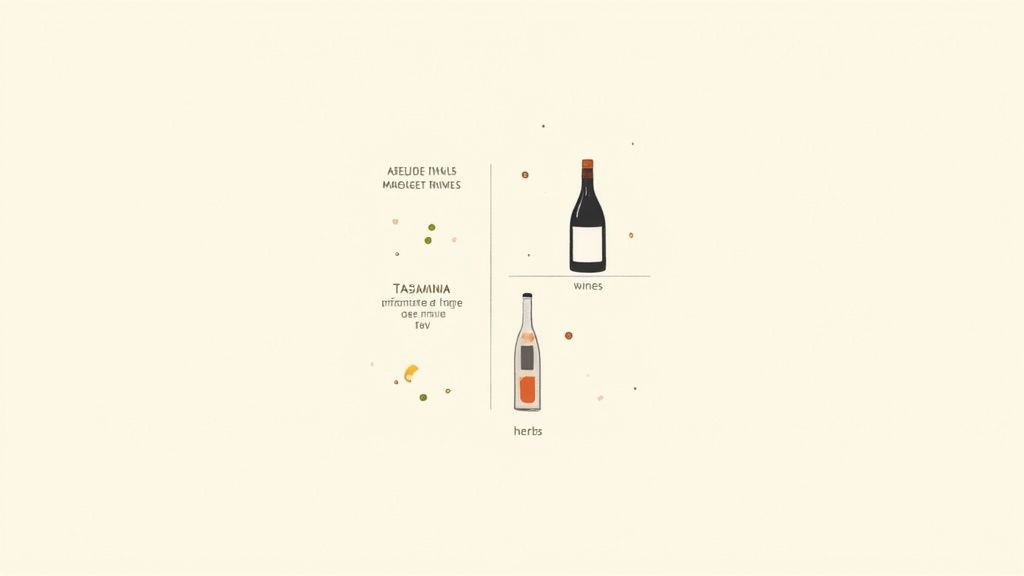
While New Zealand Sauvignon Blanc often grabs the spotlight with its famously punchy passionfruit and gooseberry notes, Australia serves up a distinctly different and equally compelling experience. Think less tropical fruit explosion and more sophisticated, textural elegance. It’s a classic tale of two styles, each shaped by its unique terroir.
Australian "Savvy," as it’s affectionately known, truly comes alive where cool ocean breezes and high altitudes work their magic, preserving the grape's natural acidity and delicate aromatics. This results in wines that are often crisper and more savoury on the palate. Forget overt fruitiness; instead, you’ll discover nuanced layers of lime zest, wet stone, and subtle herbaceous hints of freshly cut grass or capsicum.
What to Expect Inside This Guide
We’ve designed this guide to be your go-to resource for navigating the exciting world of Australian Sauvignon Blanc. We’ll cover everything you need to know to find your perfect bottle and appreciate what makes this wine so special.
Here's a taste of what's to come:
- Key Flavour Markers: We'll unpack the signature aromas and tastes that define the top-tier Aussie styles.
- Premier Wine Regions: A deep dive into the specific terroirs that produce the most acclaimed bottles.
- Expert Tasting Tips: Simple techniques to help you evaluate and appreciate every glass like a pro.
- Curated Recommendations: Our top picks from McLaren Vale Cellars, making your next purchase a guaranteed winner.
Australia’s Sauvignon Blanc production has steadily been turning heads, especially from cooler regions like the Adelaide Hills, Margaret River, and Mornington Peninsula. While it might not be as widely planted as Chardonnay, its reputation for quality is soaring. You can discover more about Australia's recent grape harvest trends on Wine Intelligence.
Join us as we uncover the craftsmanship and regional character that make the best Australian Sauvignon Blanc an absolute must-try for any white wine lover.
Defining Exceptional Australian Sauvignon Blanc
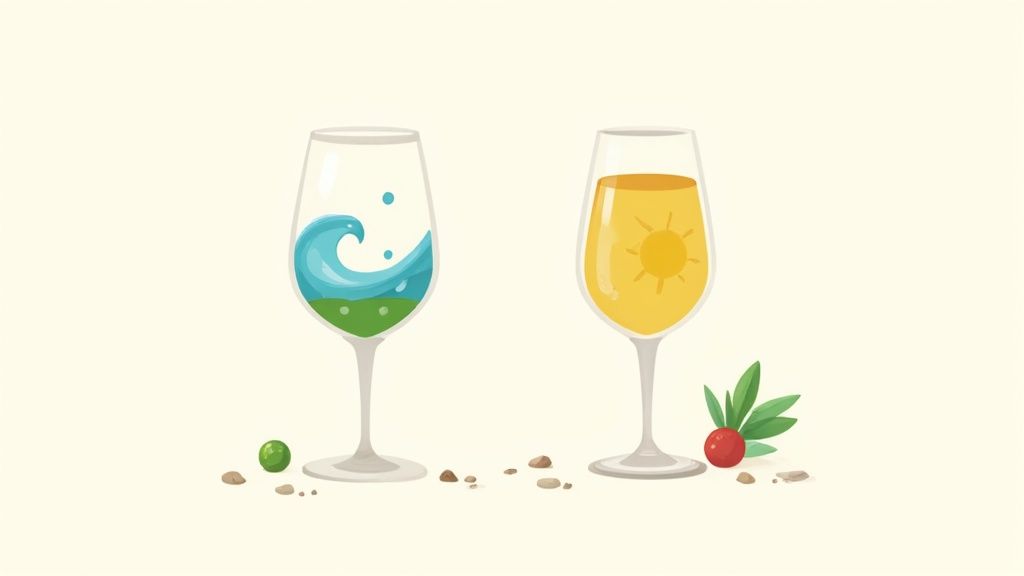
So, what separates a run-of-the-mill bottle from a truly exceptional Australian Sauvignon Blanc? It’s a delicate dance between place and practice. Every single element from the dirt under the vines to the exact moment the grapes are picked plays a critical role. Don't think of it as one single flavour, but as a finely tuned orchestra of characteristics that all need to be in harmony.
A standout Aussie Savvy just sings with vibrancy and balance. Picture the crisp, zesty style from the Adelaide Hills as a brisk, refreshing sea breeze all lime, grapefruit, and that unmistakable stony minerality. By contrast, a warmer Margaret River expression is like sunshine in a glass, giving you richer notes of passionfruit and gooseberry without ever losing its signature bright acidity.
These distinct personalities aren't just happy accidents; they are born from terroir. It's a French term that perfectly captures the complete natural environment where a wine is grown, including everything from the soil and lay of the land to the climate. And its influence is absolutely profound.
The Role of Terroir and Climate
The best Australian Sauvignon Blanc almost always comes from cooler climates. But why is that? It's because chilly nights and moderate days allow the grapes to ripen slowly. This long, slow hang time lets them develop complex flavours while holding onto their precious natural acidity. That acidity is the backbone of the wine, giving it structure and that mouth-watering finish we all love.
Ocean-cooled airflows and higher altitudes are the heroes here. They act like nature’s own air conditioner, stopping the grapes from getting overripe and losing their delicate, beautiful aromas. The soil composition makes a huge difference, too:
- Gravelly and Sandy Loam Soils: Often found in places like Margaret River, these soils drain well, forcing the vines to dig deep for nutrients. This stress can lead to more concentrated fruit flavours and a lovely herbal complexity.
- Clay and Schist Soils: Common in parts of the Adelaide Hills, these soils hold water differently, often adding to a wine's texture and a distinct mineral or "wet stone" character.
An exceptional Sauvignon Blanc tells the story of its vintage and its home. You should be able to taste the influence of the cool breezes, the ancient soils, and the winemaker's careful stewardship in every single sip.
Craftsmanship in the Vineyard
Beyond the gifts of nature, skilled hands in the vineyard are essential. Think of the winemaker as a symphony conductor, guiding all the elements to create something harmonious. One key practice is canopy management, where growers meticulously prune leaves to control exactly how much sunlight hits the grape bunches.
Too much sun can literally burn away delicate aromas, while not enough can lead to underdeveloped, overly "green" flavours. It's a knife's-edge balancing act.
Likewise, the harvest timing is absolutely critical. Picking just a day or two earlier or later can dramatically shift the wine’s profile from grassy and zesty all the way to ripe and tropical. This painstaking attention to detail is what truly defines the very best Australian Sauvignon Blanc.
Where to Find Australia’s Best Sauvignon Blanc
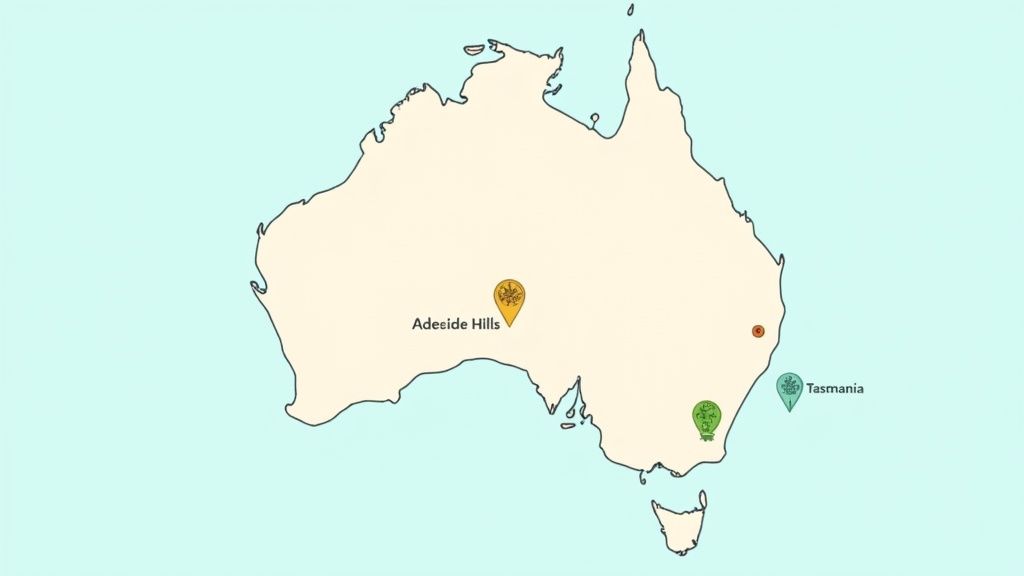
To find the best Australian Sauvignon Blanc, you have to get to know its home turf. Just like a chef’s best dishes start with incredible ingredients, a winemaker's success hangs on the unique character of their region. Australia’s huge, diverse landscape offers a patchwork of climates and soils, and each one stamps a distinct personality onto the wine.
The real secret to first-class Sauvignon Blanc is a cool climate. Chilly nights and gentle sunshine let the grapes ripen slowly, locking in those delicate aromas and that all-important zesty acidity. This is where Australia really shines, with a whole palette of brilliant regional styles.
Adelaide Hills, South Australia
You could argue this is the benchmark for Australian Sauvignon Blanc. The Adelaide Hills region is defined by its high altitude and cool, crisp air, which combine to create wines that are elegant, restrained, and packing a razor-sharp acidity.
The flavour profile here is a masterclass in subtlety. Forget loud tropical fruit; instead, you’ll find:
- Zesty Citrus: Bright, lively notes of lime, grapefruit, and lemon peel.
- Mineral Core: A distinctive "wet stone" or flinty character that adds fantastic complexity.
- Herbal Lift: Subtle hints of freshly cut grass and snow pea that keep things fresh.
These wines are vibrant and incredibly refreshing, perfect for anyone who appreciates a more savoury, mineral-driven style. They're a world away from the simple fruit-bomb styles many people associate with the grape, offering a much more sophisticated sip.
Margaret River, Western Australia
Head west to Margaret River, and you’ll find a completely different take on Sauvignon Blanc, shaped by the gentle hand of the Indian Ocean. While it’s still a cool climate, it’s a touch warmer and more maritime than the Adelaide Hills.
The result is a wine that often shows a bit more flesh and fruit, but with a beautiful herbal edge holding it all together. It’s a classic style that’s often blended with Semillon to create the region’s famous “SSB” or “Classic Dry White” blends an iconic Aussie duo.
Margaret River Sauvignon Blanc often strikes a perfect balance between the green, herbaceous notes of the Loire Valley and the ripe tropical hints of the New World, creating a style that is uniquely its own.
Tasmania and Other Cool Climate Hotspots
As Australia’s island state, Tasmania is one of our coldest wine-growing regions. This translates to Sauvignon Blanc with piercing acidity and intense aromatics. Expect lifted notes of passionfruit, gooseberry, and a clean, crisp finish that just doesn’t quit.
Other pockets of brilliance, like the Great Southern in WA and Victoria's Yarra Valley, also produce exceptional examples. The main thing to remember is that each region’s unique terroir shapes the final wine. To really get a handle on the variety, you can learn more about what makes each area special in our guide to understanding Australian wine regions.
Even in red-dominant areas, the grape’s economic importance is undeniable. Take McLaren Vale, where winery-grown fruit made up 62% of the 89 tonnes of Sauvignon Blanc crushed in 2025. That shows some serious grower confidence in its market appeal. You can dig into more stats in the McLaren Vale 2025 vintage report.
To help you navigate the nuances, we've put together a quick guide comparing the flavour profiles from Australia's key Sauvignon Blanc regions.
Australian Sauvignon Blanc Regional Flavour Profile Guide
| Region | Climate | Primary Aromas | Palate Notes | Acidity Level |
|---|---|---|---|---|
| Adelaide Hills | Cool, high altitude | Lime zest, grapefruit, wet stone, fresh-cut grass | Lemon peel, flint, snow pea, subtle green apple | High, sharp |
| Margaret River | Cool maritime | Passionfruit, gooseberry, dried herbs, lemongrass | Ripe citrus, herbal tea, hint of tropical fruit | High, refreshing |
| Tasmania | Cold, maritime | Gooseberry, passionfruit, capsicum, guava | Intense tropical fruit, zesty lime, crisp finish | Very high, piercing |
| Yarra Valley | Cool, continental | Nectarine, gooseberry, subtle floral notes | Stone fruit, fresh herbs, clean minerality | Medium-high |
This table should give you a great starting point for finding a style that suits your palate, whether you’re after something zesty and mineral or a bit more fruit-forward. Happy exploring
Top Picks for Australian Sauvignon Blanc
Alright, we've covered the what, where, and why of Australian Sauvignon Blanc. Now for the fun part; uncorking a few exceptional bottles. This isn't just a list, it's a curated selection from our cellar, chosen to show you the incredible diversity this grape has to offer.
We’ve picked out a couple of real standouts that turn all that talk about style and region into a delicious reality. Whether you crave that classic, zesty punch or something a bit more thoughtful and complex, your next favourite Savvy is waiting right here.
Singlefile Fumé Blanc – Great Southern, WA
If you're after a Sauvignon Blanc with a bit more substance and a savoury edge, the Singlefile Fumé Blanc is a must-try. Hailing from the cool, windswept Great Southern region of Western Australia, this is a world away from your typical fruit bomb. The "Fumé" in the name is a nod to its time spent in oak barrels.
Don't worry, the oak is a supporting actor here, not the star. It adds a wonderful texture and complexity without shouting over the vibrant fruit.
- Tasting Note: Expect classic grassy aromas that lead into a palate where crisp citrus and a creamy mouthfeel play off each other beautifully. There are subtle, toasty notes from the oak that are woven in perfectly, leading to a sophisticated and long finish.
- Winery Story: Singlefile is a family-owned gem known for their meticulous, hands-on approach. They hand-select grapes from the best spots across the Great Southern, aiming to create wines that are a pure and honest reflection of where they're from.
This wine is a brilliant example of how Aussie winemakers are pushing the boundaries. They're crafting Sauvignon Blanc with real depth and character – wines that make you stop and think.
Ottelia Sauvignon Blanc – Mount Gambier, SA
From the unique, limestone-rich soils of Mount Gambier, the Ottelia Sauvignon Blanc is a wine that practically screams of its cool-climate home. It’s a seriously compelling and interesting drop, known for a profile that’s vibrant and a little unconventional.
Run by John and Melissa Innes, the winery is all about sustainable farming and making wines that taste of a specific place. This Sauvignon Blanc is the perfect embodiment of that philosophy.
- Tasting Note: Get ready for vibrant leafy and "tomato bush" notes on the nose. The first sip delivers juicy stone fruit that’s perfectly balanced by savoury characters. It has a slightly oily texture with impressive depth, and it finishes with a pinch of greenness that’s lifted by just a touch of sweetness from the oak.
It’s wines like these that are part of a bigger shift across Australia. While Savvy might not have the same production numbers as Chardonnay, there’s a growing focus on terroir-driven whites from cooler pockets like Tasmania and the Adelaide Hills. According to Decanter, these regions have been posting record vintages, pointing to a very bright future for high-quality, site-specific Sauvignon Blanc.
These two bottles are just a taste of what's out there. To grab these and explore an even wider range of styles, head over to our complete collection of premium Sauvignon Blanc.
Perfect Food Pairings for Sauvignon Blanc
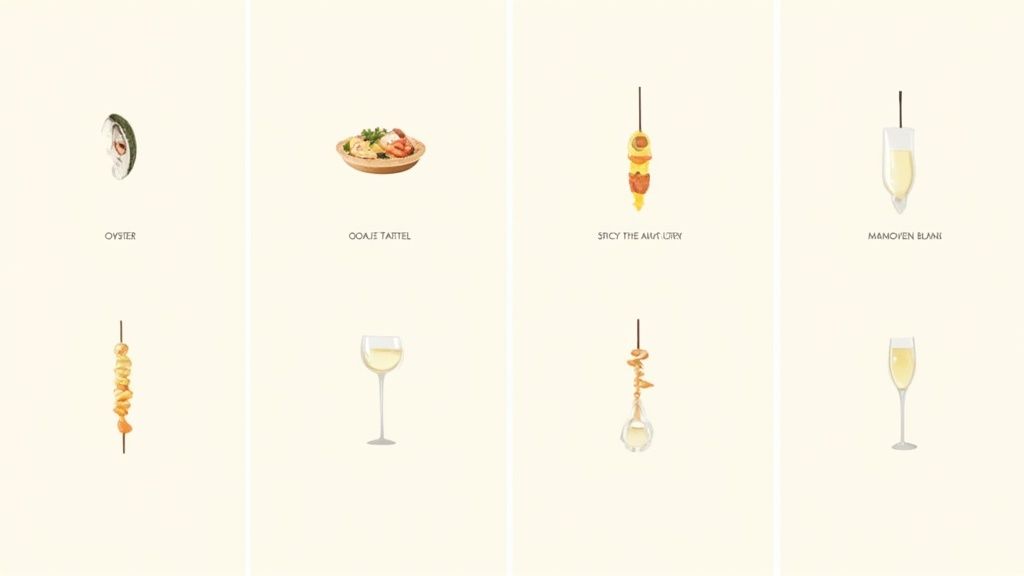
Pairing food and wine is all about creating a bit of magic on the palate, where the combination is even better than the sum of its parts. Australian Sauvignon Blanc, with its bright acidity and incredible range of flavours, is one of the most versatile wines you can bring to the dinner table. The trick is simply to match the style of the wine to the right dish.
Forget about rigid rules. The secret to great pairings is in the details. The high acidity in a good Savvy B acts like a squeeze of fresh lemon, effortlessly cutting through rich foods and cleansing your palate. Its classic citrus and herbal notes can mirror similar flavours in a meal or stand in delicious contrast. To really get it right, it helps to understand the art of wine pairing and elevate any meal from good to unforgettable.
Matching Zesty and Mineral Styles
First up, let's talk about those crisp, zesty styles you often find from cooler spots like the Adelaide Hills. These wines are all about sharp acidity, with flavours of lime, grapefruit, and a distinct "wet stone" minerality. It only makes sense that they're a perfect match for food that's just as fresh and lively.
Think seafood. It’s a no-brainer. The wine's minerality is a beautiful echo to the briny, salty character of freshly shucked oysters. They’re also absolutely brilliant with:
- Goat’s Cheese: This is a classic for a reason. The wine’s acidity slices straight through the creamy tang of the cheese. Try it with simple goat’s cheese tartlets for a truly unbeatable combination.
- Grilled Fish: A piece of grilled snapper or whiting, dressed with nothing more than lemon and herbs, is lifted to a whole new level by the wine's citrus zing.
- Green Salads: Any salad tossed in a vinaigrette dressing has found a best friend in a zesty Sauvignon Blanc.
Pairing Fruit-Forward and Textural Wines
Now, let's shift to the more fruit-driven styles, maybe from Margaret River or Tasmania, which often lean into riper passionfruit and gooseberry notes. These wines have a bit more weight and aromatic power, so they can stand up to bolder, more flavour packed dishes.
Those tropical fruit and herbal undertones make them a fantastic partner for many Asian-inspired cuisines. The wine's brightness provides a refreshing counterpoint to spice and sweetness, stopping your palate from getting overwhelmed.
The secret to a great pairing is balance. A fruit-forward Margaret River Sauvignon Blanc has the character to complement a spicy Thai green curry without getting lost, refreshing your palate with every sip.
Consider these exciting matches:
- Spicy Thai Dishes: The wine's fruitiness helps cool the chilli heat, while its herbal notes chime in perfectly with ingredients like lemongrass and coriander.
- Prawns with Mango Salsa: This is just a beautiful pairing where the tropical notes in both the wine and the dish sing together in harmony.
- Chicken Skewers: Simple grilled chicken with a zesty marinade is a brilliant and effortless match.
For more region-specific ideas, check out our guide on pairing McLaren Vale Sauvignon Blanc with suggested foods.
Serving and Storing Sauvignon Blanc
You’ve chosen a brilliant bottle of Australian Sauvignon Blanc, but getting the most out of it doesn’t stop there. How you serve it is just as crucial as the wine itself. Temperature, as any seasoned wine lover will tell you, is everything.
Serve it too warm, and those delicate, zesty aromas will fall flat. Serve it straight from a freezing fridge, and its vibrant flavours will be muted and shy.
The sweet spot for a great Savvy B is between 8-10°C. For most of us, that simply means pulling the bottle out of the fridge about 20-30 minutes before you plan on pouring a glass. This little bit of time allows the wine to open up, letting all those gorgeous citrus, herbal, and mineral notes come alive.
Proper Storage for Lasting Freshness
While most Sauvignon Blanc is crafted to be enjoyed young and fresh, a bit of care in storage ensures it’s in perfect condition when you’re ready to pop the cork. Whether you're keeping it for a few days or a few months, consistency is the name of the game.
Keep your unopened bottles well away from their three biggest enemies:
- Light: Direct sunlight and even harsh indoor lighting are kryptonite for wine. They can cause what’s known as "light strike," which dulls the flavours and ruins the experience.
- Heat: Find a cool, dark spot with a stable temperature, ideally below 20°C. Definitely avoid places like the top of the fridge, next to the oven, or a sunny kitchen bench.
- Vibration: Constant jiggling and movement can disturb the wine’s natural balance over time, so find a quiet, still place for it to rest.
Storing a bottle in the fridge upright for a few weeks is perfectly fine. But if you’re planning on cellaring it for a bit longer, lay the bottle on its side. This simple trick keeps the cork moist, preventing it from drying out and letting oxygen spoil the wine. It's an easy step that protects your wine and guarantees a perfect glass every time.
A Few Final Questions
Even after diving deep into the world of Australian Sauvignon Blanc, a few questions always seem to pop up. We get it. Let's tackle some of the most common ones so you can feel completely confident grabbing your next bottle.
Think of this as a quick chat to clear up any lingering curiosities.
Australian vs New Zealand Sauvignon Blanc
So, what’s the real difference between Aussie and Kiwi Savvy B? While they’re neighbours, their signature wine styles are worlds apart. New Zealand, especially Marlborough, is famous for that explosive, in-your-face aromatic style think powerful passionfruit, gooseberry, and a distinct capsicum punch.
On the other hand, the best Australian Sauvignon Blanc, particularly from cooler spots like the Adelaide Hills, plays a different game. It’s more about refined elegance. You’ll find zesty lime and grapefruit, a beautiful stony minerality, and a more subtle herbal note. It’s really a tale of vibrant intensity versus sophisticated complexity.
Is Australian Sauvignon Blanc Sweet or Dry?
Is it a sweet wine? Not at all. The overwhelming majority of Australian Sauvignon Blanc is made to be a completely dry wine. During fermentation, winemakers let the yeast convert almost all the natural grape sugars into alcohol, leaving virtually no sweetness behind.
Now, some examples from warmer areas might feel fruitier, giving you an impression of sweetness, but that’s just the ripe fruit talking. The wine's structure is all about that crisp, refreshing acidity, not sugar.
It's a classic case of fruitiness not equalling sweetness. That burst of tropical fruit is all in the aroma, while the wine itself finishes clean and dry on the palate.
How Long Can You Store It?
This is a wine built for immediate enjoyment. Sauvignon Blanc is all about that fresh, zesty character, so it’s at its absolute best within 1 to 3 years of its vintage date.
It’s not really a wine you stick in the cellar for a decade. Having said that, a few top-tier, exceptionally structured examples from the best producers can evolve in interesting ways. If stored perfectly, these rare bottles might develop more complex, savoury notes for up to five years. For pretty much everything else, though, the rule is simple: drink it young and fresh.
Ready to explore the crisp, elegant world of Australian Sauvignon Blanc? At McLaren Vale Cellars, we've curated a stunning collection of the very best expressions from across the country.


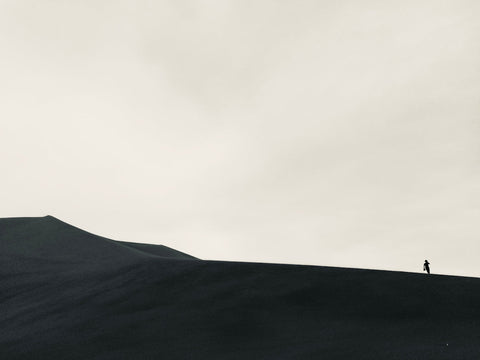

Comments (0)
There are no comments for this article. Be the first one to leave a message!